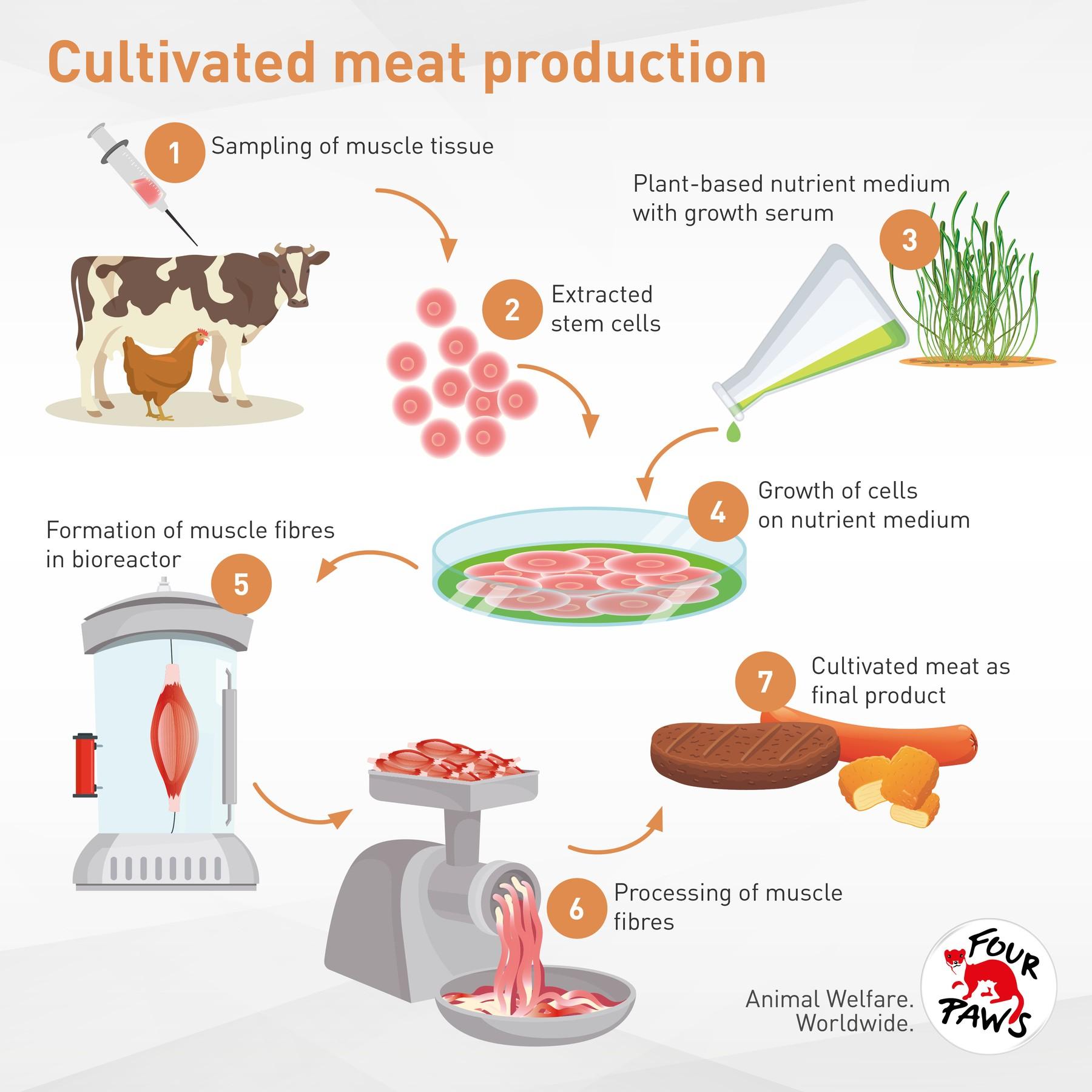
What is 'Cultivated Meat'?
Meat production without killing animals: background info on 'Cultivated Meat'
The current production of animal products, subjects billions upon billions of thinking, feeling animals to live in extreme confinement, where they experience serious trauma, mutilations, and painful slaughter. If there was a way to create meat which looked, tasted and cooked just like the 'real thing' and came from a live animal which didn’t need to be exposed to cruel keeping systems or slaughter, would the public be open to it?
How should the product be named?
There are currently a handful of start-ups which are focusing on just that; creating meat which doesn’t require animals to suffer nor die.
According to The Good Food Institute, 'Clean Meat' is a reflective term of describing real meat grown without animal slaughter, as the word is similar to 'clean energy' in that it immediately communicates important aspects of the technology – both the environmental benefits and the decrease in food-borne pathogens and drug residues. However, after in-depth consumer research conducted by Good Food Institute (GFI)1 alongside an independent food and beverage innovation firm, 'Cultivated Meat' resulted as the most appealing word. The term cultivated meat, as stated by the GFI, doesn’t exclude existing meat industry stakeholders from joining the conversation, is applicable in a regulatory context and resonates with consumers to make more informed decisions about their meat options.
A Dutch company called Mosa Meat was the first who brought 'Cultivated Meat' to the public’s attention when it was presented in London in 2013.
What exactly is 'Cultivated Meat'?
Cultivated meat – also known as cell-based, lab-grown, clean, cultured or slaughter-free meat – is a groundbreaking food innovation that could likely revolutionize the global food system.Rather than obtaining meat from animals raised on environmentally destructive factory farms who are treated as commodities instead of sentient beings which are slaughtered in appalling manners, 'Cultivated Meat' is produced by taking a small sample of stem cells-usually from lean muscle- through a harmless procedure in the same way that blood is drawn, and replicating these cells in a culture outside of the animal. After sufficient cells have grown, they are assembled in groups to form small muscle tissue that are very similar to muscle fibers in a steak. The resulting product is 100 percent real meat. In early cultivated meat research, Fetal Bovine Serum (FBS) was used to grow animal cells. Out of ethical and sustainability reasons, today many cultivated meat companies* are using animal-free (called animal component-free (ACF) cell feed), synthetic or plant-based growth media instead, aligning with a truly sustainable and cruelty-free future.
*such as Mosa Meat, Aleph Farms, Innocent meat, etc.

Cultivated Meat vs. factory farming
'Cultivated Meat' can theoretically be made from any type of animal cells (e.g. cows, chickens, pigs, fish). Looking at the amount of meat being produced worldwide and the continuous rise in consumption of animal-based products, cultivated meat could potentially reduce the numbers of animals being farmed for food and thus the need for factory farming. On top of that, the environmental and climate impact of animal agriculture and particularly factory farming could be reduced drastically.
| Status Quo (May 2025) | Cultivated Meat | Factory Farming |
| Animal Welfare | No breeding and slaughter; no intensive husbandry; no transport; reduces the need for factory farming (from an animal welfare perspective, high animal welfare standards for donor animals must be ensured) | Animal-cruelty, slaughter, animals being adapted to husbandry system; long transport of animals across countries |
| Environmental impact | Less energy and water use (depending on the production method, energy source and produced product); less land use (no feed crop agriculture) | High greenhouse gas emissions, land use (feeding + grazing), deforestation, pollution (manure), biodiversity loss |
| Health & Safety | Sterile production conditions; no need for antibiotics; enables control over fat content, nutrients, taste profiles etc. | High use of antibiotics and hormones; risk of pandemics and zoonotic diseases; limited control over composition and dependent on genetics |
| Consumer Acceptance | Still relatively unknown; diverse (varies by region e.g. it’s high in Asia, lower in EU and USA) | Widely accepted and normalised |
| Availability | Limited (available in Singapore, China, Israel) | across all countries |
| Challenges | High production costs; regulatory approvals (bans); scaling up to meet industrial level | Consequential costs caused by impact on environment, climate pandemics and animal diseases, food safety, human health and animal welfare not factored in |
Source
2. Good Food Institute, Bruce F. Cultivated meat: Why GFI is embracing new language. 2019 [accessed 2025 May 23]. https://gfi-india.org/cultivated-meat-why-gfi-is-embracing-new-language/

